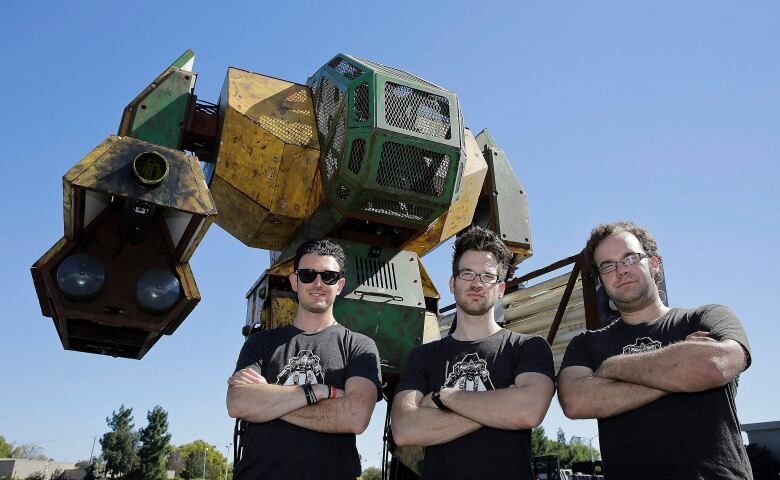Robotics engineer crowd-sources designs for COVID-19 medical supplies to help out-of-stock hospitals
'All of these people want to help because they're all shut down — they need something to do': Gui Cavalcanti
by Brent Bambury
Ever since the virus that causes COVID-19 appeared, the global supply chain for medical devices has been strained and the solutions aren't obvious.
In Canada and the U.S., governments are taking action to mobilize more production of medical supplies.
Auto parts makers are offering to shift production to ventilators, and Health Canada appears ready to relax some regulations around the manufacturing of protective devices.
Frontline workers in hospitals, ambulances, clinics and nursing homes are anticipating shortages of critical care equipment from masks to ventilators — and some are open to unorthodox solutions.
Gui Cavalcanti has one. He's a robotics engineer on the U.S. west coast. When he read about the shortage of supplies, he decided to create a Facebook group to reach out to experts who could design and build open-source, 3D-printed medical equipment.

The response was immediate. Over 22,000 people have now joined the group, and many of them are specialists.
"We have been selectively picking people who are doctors, who are medical transcriptionists, who are researchers, scientists, engineers," Cavalcanti told Day 6. "We have been putting them into a higher level organization which is essentially at this point a flash NGO."
Calvalcanti says healthcare workers on the frontlines are responding.
"I have hospitals begging me now to send them supplies."
An information source for local production
But providing medical supplies is not the aim of Cavalcanti's virtual NGO. Instead, he wants to centralize ideas.
"Our goal is to be a library to provide information," he said.
Cavalcanti's group has hundreds of posts about protective equipment. There are instructions on making gloves with a laser cutter, how to sew masks and plans for the 3D printing of various devices. Contributions come from all over the world.
If a hospital is looking for face shields, there's a document from Johns Hopkins University on how to create an assembly line to make your own. It says a team of 20 people built 1,000 shields in six hours.
Calvalcanti says he's trying to help local medical services develop their own supply chain so production could happen at the local site according to its need.
"We shouldn't be thought of as the people who are going to fix the problem, because the only people who are going to fix the problem are those in their local communities," Cavalcanti said.
Cavalcanti says hospitals will need massive supply increases of basic protective equipment as COVID-19 patients arrive, because a single patient might be in hospital for up to 20 days, with multiple medical professionals caring for them.
"They're attended by almost four or five people every day," he said. "So you have four to five people — each of them needs a mask. Each of them needs a face shield, each of them needs gloves, each of them needs protective equipment. You multiply that by 20 days and all of a sudden a single COVID-19 patient needs 100 pairs of gloves."
The issue with ventilators
But there's a debate about the ethics, safety and legality of some initiatives.
In Italy, reports that a hospital was able to save lives after it swapped out faulty ventilator valves with 3D-printed replacements, though controversial, sparked calls for people to 3D print ventilators in the United States.
"I was originally thinking we need to make ventilators," Cavalcanti said. But he was redirected by a health professional he contacted and told to focus his energy elsewhere.

"They immediately cut me off and said, 'Please don't [try to make ventilators.] If we run out of ICU physicians because they don't have masks and face shields and gloves and other protective equipment we won't need ventilators.'"
On his Facebook group there's still forceful discussion of a looming ventilator shortage and possible solutions. But Cavalcanti stresses that shortages of personal protective equipment like gloves and masks are acute and need to be addressed.
"The issue that we're seeing now is we have hospital administrators who are sitting in conference tables in Seattle tearing the plastic out of binders, taping rubber bands to those binder vinyl pieces and then using them as improvised face shields," Cavalcanti said.
"There's absolutely no reason for that. We are surrounded by fabrication shops. We are surrounded by skilled makers in their garages. All of these people want to help because they're all shut down. They need something to do."
Safety and the vulnerable
But if materials produced outside of conventional medical supply chains are of lower quality they may be dangerous, especially to the weakest and most vulnerable patients in the system.
So what if devices produced through Cavalcanti's Facebook group hurt patients?
"We're providing information," he said. "We are not providing materials. We are asking for communities to provide the materials directly to hospitals. And what our goal is, is to just inform people of the varying scale of potential solutions."
"And I am taking the perspective that this world has enough engineers in it working on these problems, but we need to be able to find them, vet them, make sure they're safe and then present them to the rest of the world."
To hear more, download our podcast.
